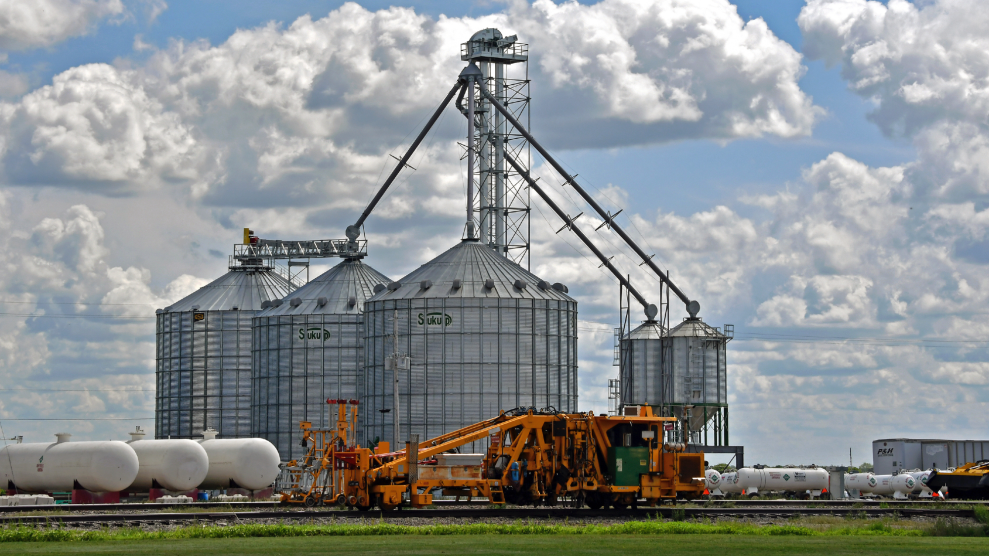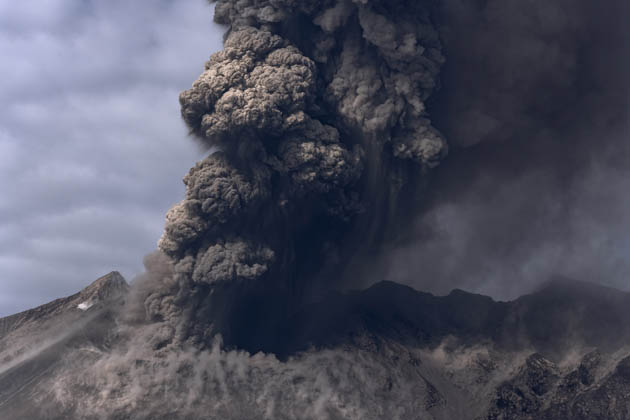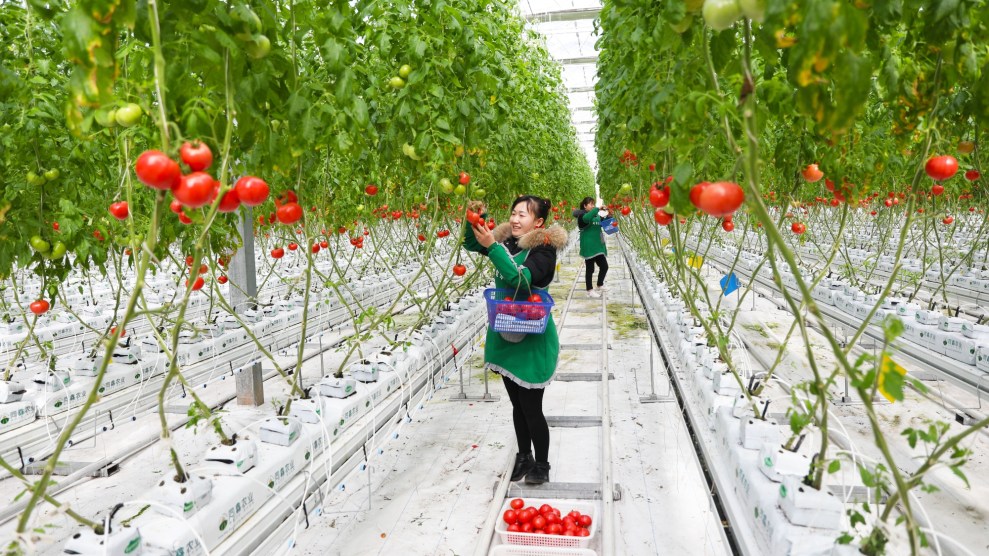
A worker picks tomatoes at the Holland Tomato Factory in Chongqing, China.Cfoto/DDP/ZUMA
This story was originally published by Yale Environment 360 and is reproduced here as part of the Climate Desk collaboration.
The world is awash with greenhouses growing fresh vegetables year-round for health-conscious urbanites. There are so many of them that in places their plastic and glass roofs are reflecting sufficient solar radiation to cool local temperatures—even as surrounding areas warm due to climate change.
The extent of this accidental climate engineering is becoming ever more apparent as analysis of satellite images dramatically increases estimates of the area of the planet swathed in greenhouses. From southern Spain to northeast China and the Rift Valley in East Africa to Mexico, millions of acres of former scrub and marginal farmland are being replaced by glistening reflective surfaces.
The intensive agricultural methods employed within greenhouses may often damage local environments by overtaxing water supplies and polluting rivers and soils with nutrients, pesticides, and plastic waste. But the influence of these seas of plastic on local temperatures can be even more dramatic—and often beneficial. They increase the albedo, or reflectivity, of the land surface, typically by around a tenth, and so reduce solar heating of the lower atmosphere.
The extent of the planet’s growing enthusiasm for greenhouses was revealed in May by a new satellite mapping exercise, which estimated the land area covered with permanent greenhouses at 3.2 million acres, an area the size of Connecticut, with China hosting more than half of this expanse. This is more than twice previous estimates, and 40 times those made four decades ago.
And the figure is just the tip of the albedo iceberg, says the study’s lead author, Xiaoye Tong, a geographer at the University of Copenhagen. He told Yale Environment 360 that if temporary coverings of crops by reflective plastic sheets were included, the figure would be 10 times higher—more like the size of New York State.
The spread of greenhouses and plastic sheeting on crops amounts to a huge climate experiment, according to researchers who believe it could offer a template for cooling urban areas—or even taking the edge off global climate change. Says Xuehua Fan, a researcher at China’s Institute of Atmospheric Physics in Beijing, “Agricultural plastic film could… be regarded as a potential geoengineering project.”
The most detailed analysis of the potential impact of this dramatic change in land use on local temperatures has been carried out since 2008 in the southern Spanish province of Almeria.
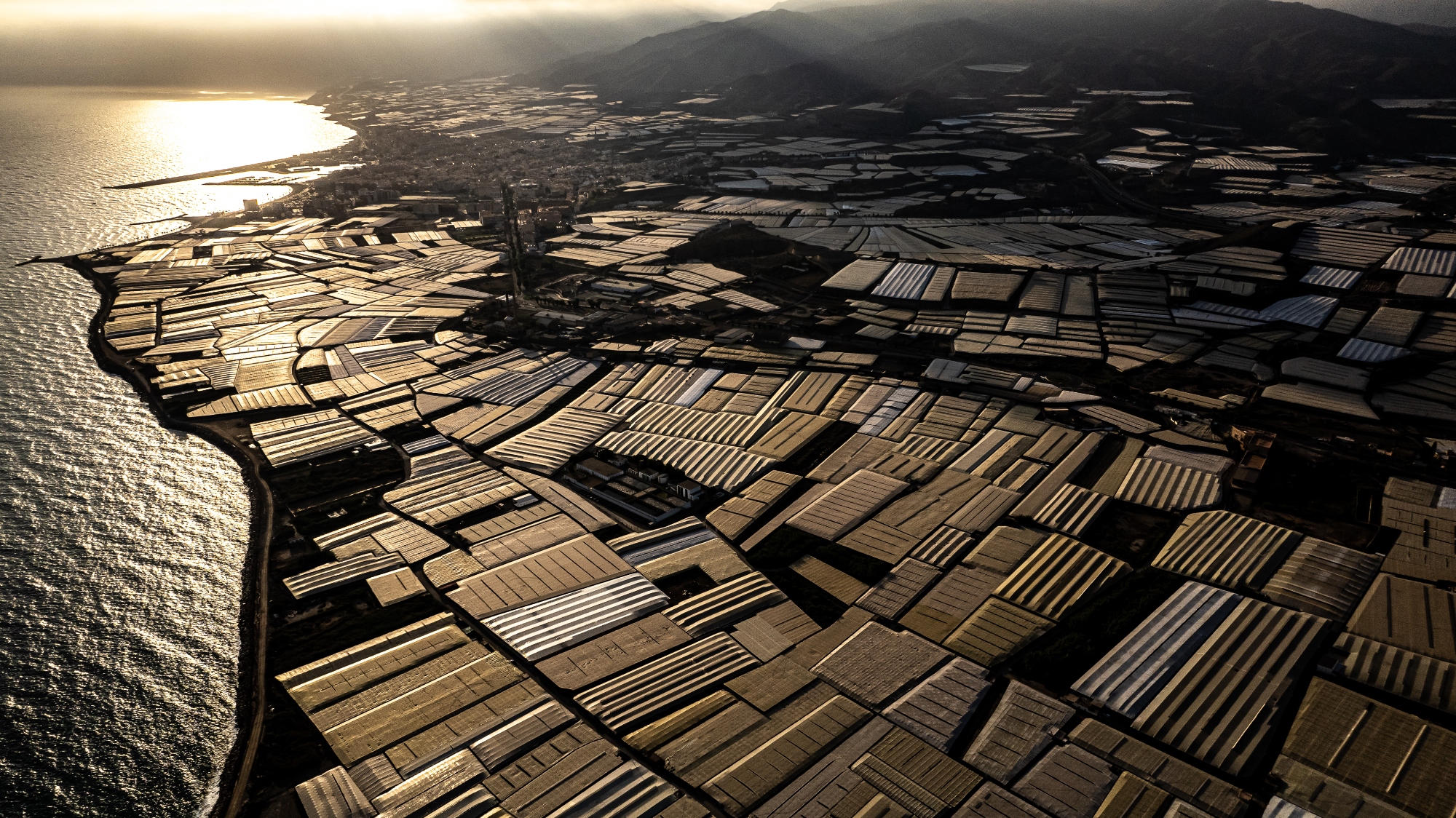
The province is one of the driest places in Europe, with only around 8 inches of rainfall each year — similar to Phoenix, Arizona. It was previously dry scrub, best known as the “Hollywood of Spain,” where so-called spaghetti westerns were filmed. Yet in the late 20th century, it accumulated the largest agglomeration of greenhouses in the world, covering 100,000 acres, and became the largest producer of fruit and vegetables in Europe.
The Campo de Dalias area of Almeria, on the Mediterranean coast, is now known variously as the Orchard of Europe and the Costa del Polythene. It has about 50,000 acres covered in plastic—more than two-thirds of the total area. It grows around 3 million tons of fruit and vegetables annually, mostly exported by truck to countries across Northern Europe, especially the UK, France, and Germany.
When agronomist Pablo Campra at the University of Almeria and colleagues analyzed the likely impact of this vast expanse of plastic, they found an increase in albedo of 9 percent, compared to the former scrub. This increase in reflectivity, they estimate, causes an average reduction in heating of almost 20 watts per square meter.
They expected a cooling effect, and they found it. Temperature records at two weather stations amid the greenhouses show an average cooling of 1.3 degrees Fahrenheit (0.7 degrees Celsius) over 23 years, compared with a warming trend in the surrounding area of more than 1.8 degrees F (1 degree C). So, the cooling caused by the vast expanse of plastic was at least 3.1 degrees F (1.7 degrees C).
The most recent and spectacular growth in greenhouse agriculture has been in China, which now has 60 percent of the world’s greenhouses
Could there be another explanation? Campra concedes the introduction of irrigation water for the greenhouses may have had a cooling effect, but he says this is likely to be small. Crops are watered by drip irrigation, so there are few expanses of open water and not much evaporation.
The effect is much like that of white roofs in urban areas, and Campra says his findings could help improve forecasts of the impact of cool-roof strategies to reduce temperatures in cities.
Spain is not alone. Other European countries have invested heavily in greenhouse cultivation in recent decades, including the Netherlands and Italy, where many vineyards are covered with plastic sheeting to reduce solar radiation and delay harvesting.
In Canada, Leamington in Ontario is famous for its tomatoes, first grown to supply a local Heinz canning factory. It claims to have more greenhouses than the whole of the United States. Mexico has more still, but they are spread widely, meaning significant cooling effects are unlikely.
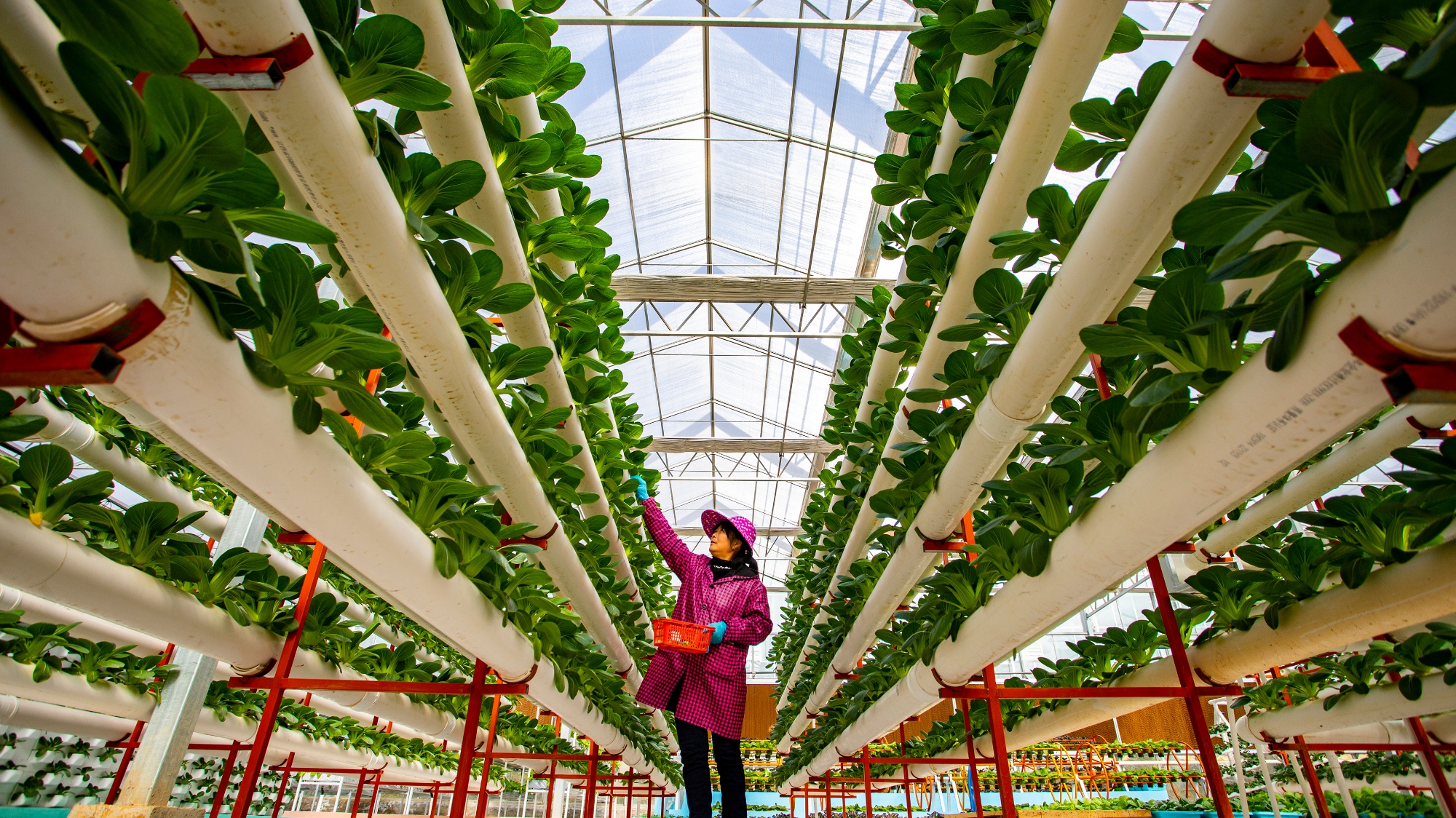
But the most recent and spectacular growth in greenhouse agriculture has been in China, which now has 60 percent of the world’s greenhouses, according to Tong’s analysis. The growth has been tied to markets for vegetables created by the rapid urbanization of the country, and a more prosperous population ending its historical dietary reliance on cabbages and switching to tomatoes, cucumbers, peppers, and eggplants. Farmers have benefited from government subsidies to construct greenhouses and incorporate “smart” technology to optimize inputs of fertilizer and water.
Weifang prefecture in Shandong in northeast China now has 200,000 acres of greenhouses, twice the coverage in Almeria. Open farmland that was once the grain-growing breadbasket of China has been transformed into a sea of plastic, producing vegetables for urban China and for export to Russia, Singapore, and elsewhere. Just one district, Shouguang, has 176,000 vegetable greenhouses covering more than 100,000 acres, a fifth of the district.
There is a wide acceptance of Tong’s new assessment of global greenhouse extent. Fernando Aguilar, a remote sensing specialist at the University of Almeria who reviewed the study prior to publication, says: “I believe that currently Tong’s figure [of 3.2 million acres of global greenhouses] is very close to reality.”
But Tong says the area of the planet covered in plastic is probably an order of magnitude greater. His study only covers permanent structures and does not include the widespread temporary polyethylene covering of crops during the growing season. Often called plastic mulch, the covering—designed to suppress weeds, protect against frosts, and conserve water by reducing evaporation—has a similar reflective impact to greenhouses.
“The figures for these thin mulching films are crazily higher than just permanent greenhouses,” Tong told E360. “In China we have approximately 20 million hectares [50 million acres] of crops covered by this plastic film,” growing everything from tomatoes in Shandong to coconuts in Hainan and cotton in Xinjiang. This figure originates from Yan Changrong, at the Chinese Academy of Agricultural Sciences in Beijing.
Unlike Almeria, however, Shandong is not cooling, says Tong. “Temperatures here seem consistently higher compared to the surroundings. I was not able to explain this,” he said. Anecdotally, he says, farmers there talk about reduced rainfall, which could increase temperatures.
Another possible reason could be that Shandong was until recently plagued by dense smogs that shaded the sun. Government-mandated clean air controls have dramatically reduced smogs in recent years, boosting warming in Shandong and elsewhere in eastern China. This surge in temperatures could mask the cooling effect of the greenhouses.
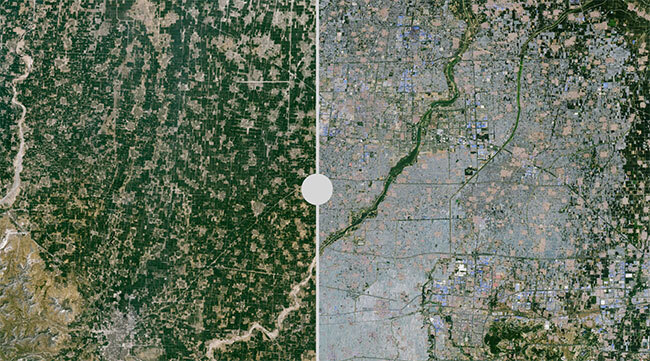
Proponents of greenhouses often claim that their intense farming methods use resources more efficiently, including land—thus reducing threats to the wider environment, such as deforestation. Campra argues that the cooling effect of greenhouses can be seen as a further ameliorating factor, because it reduces the climate footprint of food production. He calculates that in Almeria, greenhouses reduce the global warming impact of growing the crops that Europe eats by 45 percent, with both a local and global cooling effect.
But the sheer intensity of greenhouse operations can pose severe local environmental problems. With the majority of greenhouses now in the Global South, they can also threaten scarce resources needed by local farmers and households, especially water for irrigating crops.
A case in point are the lakes of the arid Rift Valley in Ethiopia. Lake Ziway, a large freshwater lake in the valley covering some 170 square miles, is an important source of irrigation for local smallholders, as well as a major center for fishing and an important wintering ground for flamingos and other water birds migrating from Europe.
But Lake Ziway is in trouble. Water withdrawals are largely unregulated, and in recent years the lake has lost around 20 inches in depth as it is emptied by farmers, particularly by the owners of hundreds of greenhouses that line its shores.
The largest greenhouse operator is Sher Ethiopia, a Dutch-owned company that claims its three farms here are the biggest rose growers in the world. Its greenhouses cover 1,600 acres and airfreight up to 4 million roses every day from Addis Ababa to Amsterdam, for distribution to retail chains across Europe.
Sher Ethiopia says it recycles all the wastewater from its greenhouses, using a purpose-built wetland to clean up nutrients. But much of the water it extracts from the lake is not available for recycling, because it is incorporated into the roses themselves.
During a past visit to the lake with the NGO Wetlands International, I saw numerous large pumps at work on the shore, supplying the 3,000 miles of driplines constantly feeding water to Sher’s roses.
The company does not publish full data on how much water it extracts from the lake, though a 2020 report gave an annual figure of more than 3 acre-feet per acre, equivalent to around 4,500 acre-feet each year. “The amount of water that we extract from the lake differs from year to year and depends on the amount of rainfall and the weather conditions in general,” a spokesperson told e360.
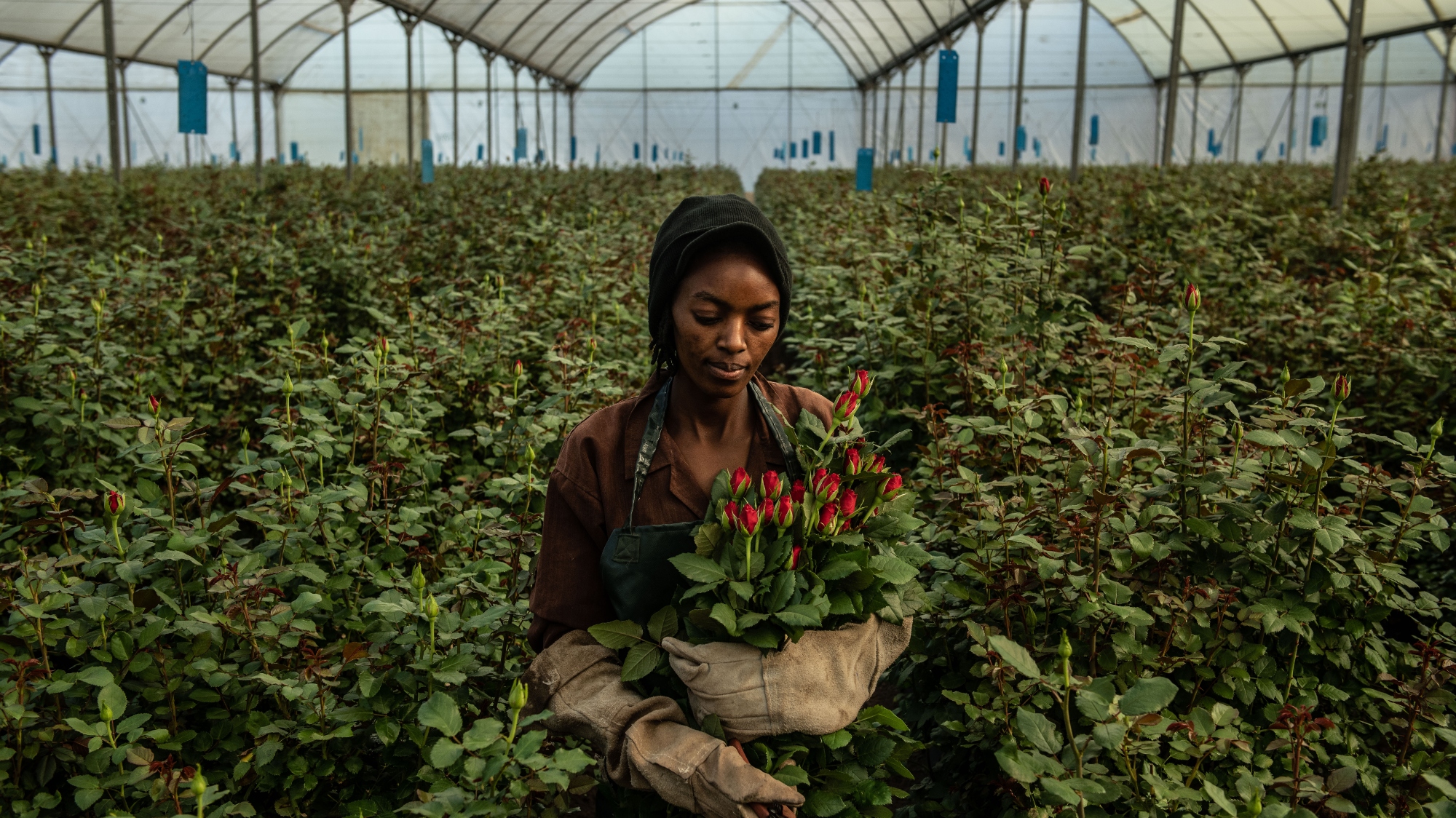
Its website claims that “there are no water shortages” in the region. But I met local farmers who find it increasingly difficult to get water to irrigate their crops because the lake is shrinking.
“This land was part of the lake once, but now the lake is in the far distance,” said Abule Debele, as he struggled to repair a small pump that drew water to his fields from Lake Ziway. The lake’s shore was more than a mile away. He blamed the proliferation of greenhouses. Fish catches in the lake have fallen by two-thirds since the greenhouses began to be built, said Nugusa Ushe, head of environment for the local district council. And Alemseged Haile of the International Water Management Institute, based in Addis Ababa, predicts the lake will lose more than a quarter of its volume by 2038.
Water is an important issue elsewhere, too. The greenhouses of Almeria get 80 percent of their water from underground aquifers. They export more than 2,000 acre-feet of this water each year in vegetables. This is damaging natural ecosystems in the area that depend on groundwater, notably the Punta Entinas wetland, which has freshwater ponds visited by some 130 bird species each year.
Waste plastic from greenhouse and plastic mulches is also increasingly recognized as an environmental hazard. The greenhouses of Almeria generate more than 30,000 tons of plastic waste annually. Much of it ends up ingested by birds, blanketing riverbeds, and floating in the ocean. A sperm whale offshore from Almeria washed up dead in 2013 with 37 pounds of plastic sheeting from greenhouses in its gut.
In China, the thin plastic film from plastic mulches “is slow to degrade, easily damaged, difficult to reuse… and difficult to remove,” says Yan. So it is left in the fields. He has found up to 230 pounds of plastic particles in a typical acre of soil on fields used over multiple years—enough to reduce plant growth by up to a fifth. Microplastics also enter the food chains of both people who eat the vegetables and wildlife.
Such concerns leave many researchers hesitant to recognize greenhouses as an environmental plus, however beneficial their climatic impact may be.
“For a real local cooling effect to occur, there must be a large concentration of plastic greenhouses,” says Aguilar. “However, such high concentrations cause adverse environmental impacts, so from my point of view, it is not advisable to use this intensive agriculture model with the exclusive purpose of producing local cooling and reducing the incidence of climate change.”
Still, says Tong, the fact remains that greenhouses—or other reflective surfaces, such as the roofs of urban buildings—can be used to cool the immediate area and stave off the worst effects of a warming climate. It may be “accidental geo-engineering,” but it works.
